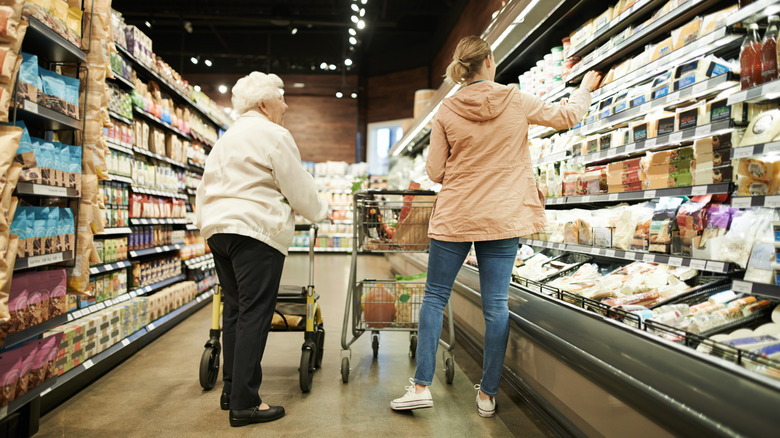How Swapping Grocery Store Carts For Baskets Saves You Money
When we go shopping at the supermarket, not grabbing a shopping cart is usually bad etiquette, as it can cause you to drop and damage items, for starters. However, what this rule really boils down to is this: Use something to safely carry your groceries while you shop, whether it be a cart, personal bag, or a basket. In fact, using a basket can help you stick to your shopping list and save money.
Obviously, baskets are much smaller than shopping carts, which makes them a poor choice for a huge haul. In other cases, though, having less space available means you'll be less likely to overbuy. When using a cart, you might feel inclined to fill all that space with products you don't need, but are tricked into buying, thanks to appealing grocery displays and other marketing strategies. If you have the space in your cart, what's the harm in tossing in extra items? The answer is that you end up paying more for products you might not even use or enjoy.
Using a basket also significantly reduces the amount of time you spend in the store. According to a 2020 study published in the Journal of Business Research, the average basket-using trip takes about 7 minutes, as compared to just over 13 minutes for a cart-using trip. In addition to helping you buy less items, which cuts down on time spent browsing and checking out, baskets can get heavy, which encourages you to finish up your trip faster.
Grocery store carts force customers to slow down
Whereas shopping baskets don't slow down customers too much, carts are bulkier to maneuver. In addition to causing traffic jams in the aisles, shopping carts can encourage customers to walk through more of the store. After all, you've got all this space in your cart and you don't have to actively carry it, so you might as well take the long way around and see if anything's on sale in the other departments.
Combine this with long grocery store aisles packed with products and the way that stores constantly rearrange their layouts, and you'll wind up walking up and down every aisle and seeing more and more products to tempt you. Even if you just try to find items that are actually on your shopping list, your cart will slow you down for maximum exposure to all the available products on display. According to a study published on ScienceDirect, shoppers that use a cart cover more ground than basket-using customers. Way more products might find their way into your cart on impulse. This means cart-users will ultimately pay a larger total at checkout –- likely larger than they intended –- compared to those who used a basket.
Ways to save money even when using a cart
There's another side to the cart-versus-basket debate: Shopping baskets aren't the most feasible option for every grocery store customer, even if they're more ideal financially. For example, elderly or physically disabled customers may struggle to hold or carry a basket, particularly as more and more items are added and the basket becomes heavier. They may have to rely on others for help or simply use a shopping cart, which can also be cumbersome.
However, even if you have to use a shopping cart, there are a number of strategies you can employ to still save money. One helpful practice is to go into your shopping trip with a list and stick to it no matter what. If you strictly only buy what's on your list, you won't wind up with a cartful of impulse purchases. Additionally, you can eat a meal or even just a snack before you go shopping. This means you won't be hungry at the store, so you'll be much less likely to throw extra items into your cart purely out of cravings. You can also compare prices across brands, as store brands are frequently cheaper than name-brand items while mostly delivering the same experience. Your wallet will thank you.



